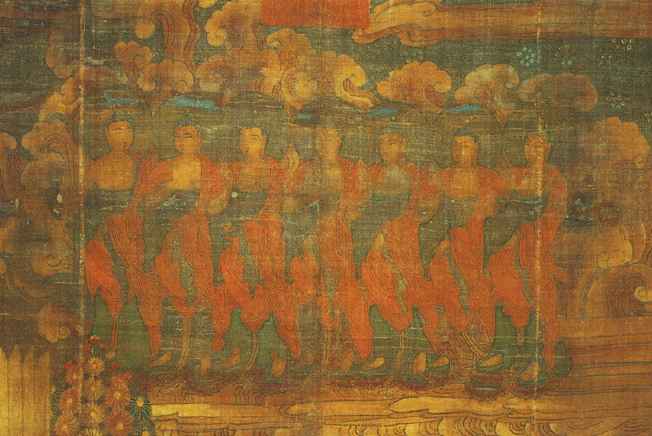 |
 |
- Search
| Korean J Art Hist > Volume 307; 2020 > Article |
|
Abstract
Abstract
Notes
1) The upper register of the Sweet-Dew painting also frequently includes the Amitābha triad (Amitābha attended by Avalokiteśvara and Mahasthamaprapta, or Kṣitigarbha replacing the latter), a set of two bodhisattvas, Avalokiteśvara and Kṣitigarbha, the Bodhisattva Guide of Souls (Illowang posal 引路王菩薩), and heavenly beings. Nevertheless, the assemblage of Buddhas is the only iconographic component that invariably appears in the extant specimens of the Sweet-Dew painting from the Chosŏn period, apart from the Bodhisattva Guide of Souls who takes less visual prominence.
2) Hong Yunsik, Han’guk purhwa ŭi yon’gu 韓國佛畵의 硏究 (Iri: Wŏn’gwang taehakkyo ch’ulp’anbu, 1980), 185-188; Kim Sŭnghŭi, “Chosŏn shidae Kamnodo ŭi tosang yŏn’gu” 朝鮮時代 甘露圖의 圖像硏究, Misulsahak yŏn’gu 196 (December 1992): 24-25, table 2; idem, “Kamnot’aeng ŭi tosang kwa shinang ŭirye” 甘露幀의 圖像과 信仰 儀禮 in Kamnot’aeng 甘露幀, 2nd ed., ed. Kang Upang and Kim Sŭnghŭi (Sŏul: Yegyŏng, 2010), 456, table 2. Both authors do not specify the latter source, but the Food-Bestowal chapter of Sŏngmun ŭibŏm includes two different sets of the invocation of Buddhas (ch’inyang sŏngho 稱量聖號), the Five Buddhas and the Seven Buddhas for the kwanŭm shishik 觀音施食 (Avalokiteśvara Food Bestowal) and the kubyŏng shishik 救病施食 (Healing through the Bestowal of Food), respectively. See An Chinho, ed., Sŏngmun ŭibŏm 釋門儀範 (Kyŏngsŏng: Mansanghoe, 1935; Sŏul: Pŏmnyunsa, 2001), 475, 494-495. Citations refer to the Pŏmnyunsa edition.
3) Pak Ŭnkyŏng, Chosŏn chŏngi purhwa yŏn’gu 조선 전기 불화 연구 (Sŏul: Shigongat’ŭ, 2008), 366-367, table 3-13. For a general discussion of the textual basis of the Buddhas depicted in the Sweet-Dew painting, see Hattori Yoshio, “Chōsen lichō butsuga “shoki kanrotei” no sekai: Ōtsu shi Seikyōji shozō Urabonkyō setsusō o yomu” 朝鮮李朝仏画 <初期甘露幀> の世界: 大津市西敎寺所藏 《盂蘭盆経説相》 を読む, Ajia yūgaku 29 (2001): 104-108.
4) See Yun Ŭnhŭi, “Kamnowangdo tosang ŭi hyŏngsŏng munje wa 16, 17 segi Kamnowangdo yŏn’gu: Suryukchae ŭigwejip kwa kwallyŏn hayŏ” 甘露王圖 圖像의 形成 문제와 16, 17세기 甘露王圖 硏究: 水陸齋 儀軌集과 관련하여 (Master’s thesis, Tongguk University, 2003), 72-73.
5) Pak Chŏngwŏn, “Chosŏn shidae Kamnodo yŏn’gu” 조선시대 감로도 연구 (PhD diss., Tongguk University, 2020), 49.
6) For example, see Kang Pyŏntong and Yi Sŭnghŭi, “Sŏnamsa muhwagi Kamnot’aeng kwa suryuk ŭishingmun ŭi yŏn’gwansŏng koch’al” 仙巖寺 無畵記 甘露幀과 水陸 儀式文의 연관성 古察, Chohyŏng nonch’ong 11 (January 2007): 3-16; Yŏn Cheyŏng, “Ŭiryejŏk kwanjŏm esŏ Kamnot’aenghwa wa Suryuk’wa ŭi naeyong pigyo” 儀禮的 관점에서 甘露幀畵와 水陸畫의 內容 비교, Pulgyohak yŏn’gu 16 (April 2007): 265-297; Pak Ŭnkyŏng, “Ilbon sojae Chosŏn 16 segi suryuk’oe purhwa, Kamnot’aeng” 일본 소재 조선 16세기 수륙회 불화, 감로탱, in Chosŏn shidae Kamnot’aeng: Kamno 朝鮮時代 甘露幀: 甘露 (Yangsan: T’ongdosa sŏngbo pangmulgwan, 2005), 1:255-300. Pak Chŏngwŏn particularly advocates the title “Suryuk’oedo” (Water-Land Assembly) based on the viewpoint that the Sweet-Dew painting illustrates the actual event of the Water-Land Ritual. Pak, “Chosŏn chŏngi suryuk’oedo yŏn’gu” 朝鮮前期 水陸會圖 硏究, Misulsahak yŏn’gu 270 (June 2011): 35-65.
7) Chŏng Myŏnghŭi, “Chosŏn shidae pulgyo ŭishik ŭi samdan ŭirye wa purhwa yŏn’gu” 朝鮮時代 佛敎儀式의 三壇儀禮와 佛畵 硏究 (PhD diss., Hongik University, 2013), 158-160.
8) This article is a revised and expanded version of part of the fourth chapter of my dissertation conducted based on the seventy-four extant Sweet-Dew paintings from the Chosŏn period. See Taylor Pak, “Shaping the Economy of Salvation: The Gamno Paintings of the Joseon period (1392-1910)” (PhD diss., Seoul National University, 2018), 231-239, appendix 1. The list includes four underdrawings.
9) Hereafter, an English translation of the title is followed by parentheses that contain the romanization of the Korean title under which each individual painting is commonly known in modern scholarship and the date of its production.
11) The two paintings exceptionally share a near-identical iconographic composition. Such degree of compatibility is quite unusual, since the surviving examples tend to show a high degree of individuality, only with the exception of the nineteenth-century works from the areas of Sŏul and Kyŏnggi Province. Further research may be required to evaluate their association. For the latter painting, see Myŏngin auction, The 2nd Myŏngin Auction Sale (June 2017): 74-75, fig. 78.
12) Kim Sŭnghŭi contends that these arrangements had been occasioned by the influence of Pure Land faith, which dominated the early phase of iconographic development of the Sweet-Dew painting. Kim, “Uhak munhwajaedan sojang Kamnot’aenghwa: tosang ŭi ŭimi wa hwamyŏn kusŏng ŭl chungshim ŭro” 宇鶴文化財團 所藏 甘露幀畵: 圖像의 意味와 畵面 構成을 중심으로, Tanho munhwa yŏn’gu 5 (December 2000): 17. For a similar view, see Pak Ŭnkyŏng, Chosŏn chŏngi purhwa yŏn’gu, 368.
13) The Sweet-Dew painting (Kamnodo 甘露圖, 18th-19th cent.) in the collection of Korea University Museum is another exceptional case. It exhibits a centrally positioned group of five seated and two standing figures of Buddhas. However, it still belongs to the fifty-seven specimens representing a single composition of the Seven Buddhas in table 1, since the accompanying cartouche confirms the assemblage as the representation of the Seven Buddhas. For an illustration, see Kang Upang and Kim Sŭnghŭi, Kamnot’aeng 甘露幀, 2nd ed. (Sŏul: Yegyŏng, 2010), 179, fig. 21. The cartouches appended to the painting is listed in T’ongdosa sŏngbo pangmulgwan, Chosŏn shidae Kamnot’aeng: Kamno 朝鮮時代 甘露幀:甘露 (Yangsan: T’ongdosa sŏngbo pangmulgwan, 2005), 2:133.
14) It includes the Ssanggyesa Kamnodo 雙溪寺 甘露圖 which represents both the Seven Buddhas and the Five Buddhas.
15) Two others examples are housed in the Ssanggyesa Museum (Unhŭngsa Kamnodo 雲興寺 甘露圖, 1730) and Wŏn’gwang University Museum (Kamnodo 甘露圖, 1750). For sources of illustrations, see note 8 above.
16) Five other examples include the paintings in private collections (Kamnodo 甘露圖, 1661 and Yŏch’ŏn Hŭngguksa Kamnodo 麗川 興國寺 甘露圖, 1741), the Sŏnamsa Museum (Sŏnamsa Kamnodo 仙巖寺 甘露圖, 18th cent.), and Leeum, Samsung Museum of Art (Kamnodo 甘露圖, 18th cent.) and the underdrawing (18th cent.) by Monk Pyŏngjin 炳震. Ibid.
17) Giebel, “Taishō Volumes 18-21,” in Esoteric Buddhism and the Tantras in East Asia, ed. Charles D. Orzech, Henrik H. Sørensen, and Richard K. Payne (Leiden: Brill, 2011), 35.
18) For a discussion of the rapid increase in the publications of Buddhist ritual texts, particularly of the Water-Land manuals, in the sixteenth and seventeenth centuries, see Nam Hŭisuk, “16-18 segi pulgyo ŭishikchip ŭi kanhaeng kwa pulgyo taejunghwa” 16-18세기 佛敎儀式集의 간행과 佛敎大衆化, Han’guk munhwa 34 (December 2004): 115-120; idem, “Publication of Buddhist Literary Texts: The Publication and Popularization of Mantra Collections and Buddhist Ritual Texts in the Late Chosŏn Dynasty,” Journal of Korean Religions 3, no. 1 (April 2012): 16-20. The emergence of independent publications of the Food-Bestowal manuals in the sixteenth century is discussed in Pak, “Gamno Paintings,” 83-95.
19) An overview of the development of food-bestowal practices in China and the related esoteric texts is included in Charles D. Orzech, “Esoteric Buddhism and the Shishi in China,” in The Esoteric Buddhist Tradition, ed. Henrik H. Sørensen (Copenhagen: The Seminar for Buddhist Studies, 1994), 51-72; for a comprehensive study on this topic, see Hun Y. Lye, “Feeding Ghosts: A Study of the Yuqie Yankou Rite” (PhD diss., University of Virginia, 2003).
22) These texts are commonly attributed to Amoghavajra (Bukong Jin’gang 不空金剛, 705-774), but they probably date from the Yuan period (1271-1368). Charles D. Orzech “Fang Yankou and Pudu: Translation, Metaphor, and Religious Identity,” in Daoist Identity: History, Lineage, and Ritual, ed. Livia Kohn and Harold D. Roth (Honolulu: University of Hawai’i Press, 2002), 221; Lye, “Feeding Ghosts,” 337-350. Daniel B. Stevenson also advocates Lye’s argument. Stevenson, “Buddhist Ritual in the Song,” in Modern Chinese Religion, ed. John Lagerwey and Pierre Marsone (Leiden: Brill, 2015), 1:359-340n44. The Korean Buddhist Canon (Koryŏ taejanggyŏng 高麗大藏經) does not include the three canonical texts listed in table 2. See Lewis R. Lancaster and Sung-bae Park, The Korean Buddhist Canon: A Descriptive Catalogue (Berkeley: University of California Press, 1979), 162.
25) “由稱多寶如來名號加持故, 能破一切諸鬼多生已來慳悋惡業, 即得福德圓滿,” T. 1313, 21.465a14; “曩謨寶勝如來除慳貪業福德圓滿,” T. 1315, 21.467c07.
26) “曩謨甘露王如來灌法身心令受快樂,” T. 1315, 21.467c17. The translation is adopted from Lye, “Feeding Ghosts,” 430.
29) For example, see HPC 2:240a. The original Koryŏ edition is not currently extant, but the postscript of Yi Chehyŏn 李齊賢 (1287-1367) written in 1342 attached to later publications reveals the name of the compiler; for example, see the Ssangbongsa 雙峰寺 edition (1562) preserved in Tongguk University Library.
30) For example, see HPC 1:609a16-610b8. The text is also commonly referred to as Chibanmun 志盤文 (Text of Zhipan) after the name of the original compiler, the Chinese Tiantai 天台 monk Siming Zhipan 四明志磐 (fl. 13th cent.).
33) HPC 1:470a1-490b. Grand Queen Dowager Insu 仁粹 (1437-1504) and Queen Chŏnghyŏn 貞顯 (1462-1530) commissioned the carving of the Samdan shishingmun jointly with the Chinŏn’gwon’gong 眞言勸供 (Instructions on Making Offerings with Mantras) for the repose of the deceased King Sŏngjong 成宗 (r. 1469-1494). Monk Hakcho 學祖 (n. d.) is known to have edited the two texts and compiled them into one book; and four hundred copies were printed at Wŏn’gaksa 圓覺寺 in the capital. In spite of the fact that such altered configuration of the Seven Buddhas is first seen in the Samdan shishingmun, the impetus for the change is uncertain. We may only surmise that the text is a redacted compilation premised on the prevalent contemporaneous manuals of the Water-Land (which had been already adapted to the liturgical setting of Joseon Buddhism) and the original Chinese manual of the Food-Bestowal authored by Mengshan Deyi 蒙山德異 (ca. 1232-1308), prior to the publications of the Chŭngsu sŏn’gyo shishik ŭimun 增修禪敎施食儀文 (Revised and Augmented Ritual Manual for the Performance of Food Offerings in Sŏn and Kyo) and Taech’al samyŏngil yŏnghon shishik ŭimun 大刹四明日迎魂施食儀文 (Text for the Ritual of Welcoming Back the Spirits with Food in Great Temples on the Four Bright Days). Mengshan’s authorship nevertheless needs further investigation. See Pak, “Gamno paintings,” 88n199.
35) HPC 1:481b17-483a14. The Many Treasures and Sweet-Dew King are regarded as a single entity (tongch’e 同體), respectively, with the Precious Victory (Kr. Posŭng yŏrae 寶勝如來) and Infinite Light (Amit’a yŏrae 阿彌陀如來). Sim Sanghyŏn, Pulgyo ŭishik kangnon 佛敎儀式各論, vol. 3, Iryong ŭibŏm 日用儀範 (Sŏul: Han’guk pulgyo ch’ulp’anbu, 2002), 278-291. In this regard, the configuration of the Seven Buddhas shown in table 3 can be an expansion of the Five Buddhas specified in the Bestowing Food and Water Method.
37) Three other titles found in the written record (hwagi 畵記) attached to several specimens of the Sweet-Dew painting are Hadant’aeng 下壇幀 (a hanging scroll of the Low-Altar), Kamnohoe 甘露會 (Sweet-Dew Assembly) and Kamnot’aeng 甘露幀 (or Kamnot’aenghwa 甘露幀畵, a hanging scroll of the Sweet Dew). Although different titles had prevailed during the sixteenth to eighteenth centuries, only the last-mentioned title continued into the nineteenth century.
38) See Mun Myŏngtae, Han’guk ŭi purhwa 韓國의 佛畵 (Sŏul: Yŏrhwadang, 1977), 95-98. The title “Sweet-Dew King” was initiated by Mun Myŏngtae in the late 1970s. The art-historical publications thereafter frequently espoused this title until the “Sweet Dew” (Kamot’aeng 甘露幀 or Kamnodo 甘露圖) gained general acceptance among scholars in the late 1990s. For example, see Kim Jŏnghŭi, Han’guk ŭi mi 韓國의 美, ed. Kim Wŏnryong et al. (Sŏul: Chungang ilbo, 1984), 16:230-233; An Kwisuk, “Chosŏn hugi purhwasŭng ŭi kyebo wa Ŭigŏym pigu e kwanhan yŏn’gu” 朝鮮後期 佛畵僧의 系譜와 義謙比丘에 관한 硏究, Misulsa yŏn’gu 9 (December 1995): 158-164; Yu Mari, “Chosŏnjo Kamnowangdo ŭi yŏn’gu” 朝鮮朝 甘露王圖의 硏究, in Chsŏnjo purhwa ŭi yŏn’gu 朝鮮朝 佛畵의 硏究, ed. An Kwisuk, Kim Chŏnghŭi, and Yu Mari (Sŏngnam: Han’guk chŏngshin munhwa yŏn’guwŏn, 1993), 2:113-180. In Western scholarship, Pierre Cambon similarly contended that the genre takes the theme of the “Amṛta-Raja.” See Cambon, L’Art Coréen au Musée Guimet (Paris: Reunion des Museés Nationaux, 2001), 329.
40) The four Sweet-Dew paintings include the Ch’ŏngnyongsa Kamnodo 靑龍寺 甘露圖 (1692), Namjangsa Kamnodo 南長寺甘露圖 (1701),Haeinsa Kamnodo 海印寺 甘露圖 (1723), and Pongjŏngsa Kamnodo 鳳停寺 甘露圖 (1765). For the full text of the written records attached to these paintings, see Kogyŏng et al., Han’guk ŭi purhwa hwagijip 韓國의 佛畵 畵記集 (Sŏul: Sŏngbo munhwajae yŏn’guwŏn, 2011), 968-970, 978.
41) The first section of this article discusses different configurations of the assemblage of the Seven Buddhas represented in the Sweet-Dew painting; see also table 1.
Fig. 1.
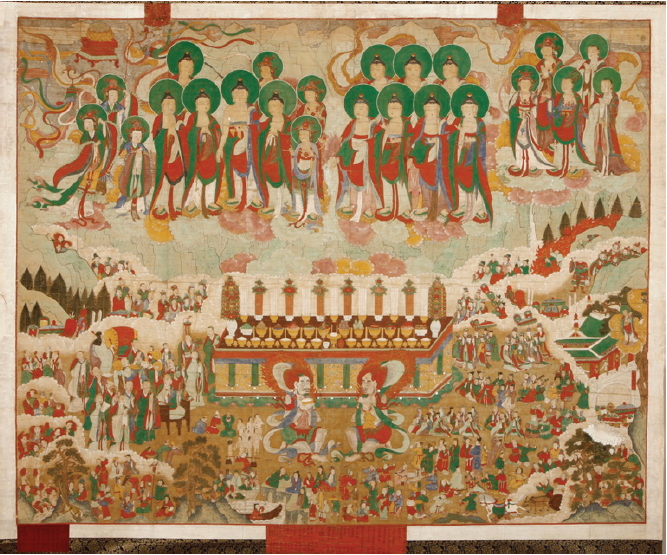
Fig. 2.
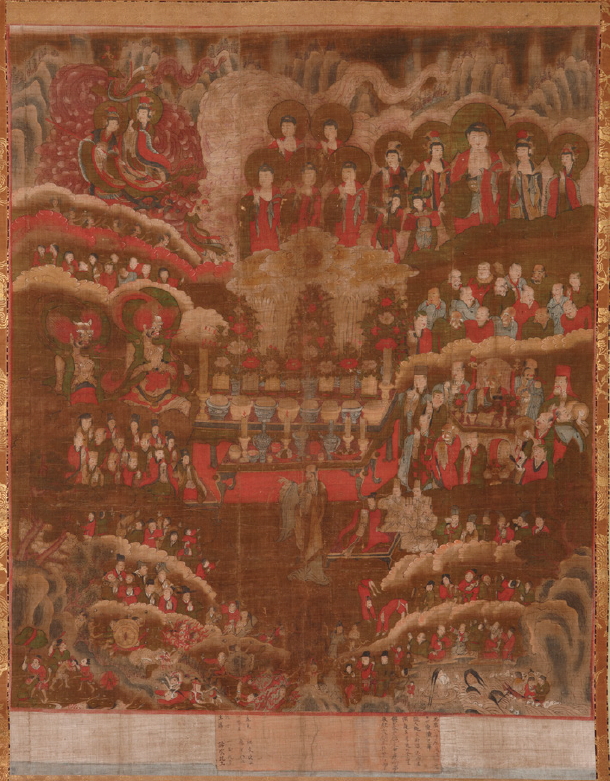
Fig. 3.
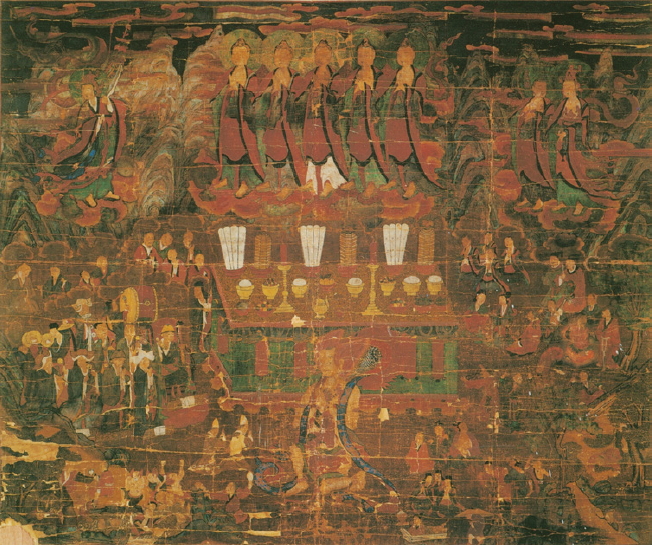
Fig. 4.
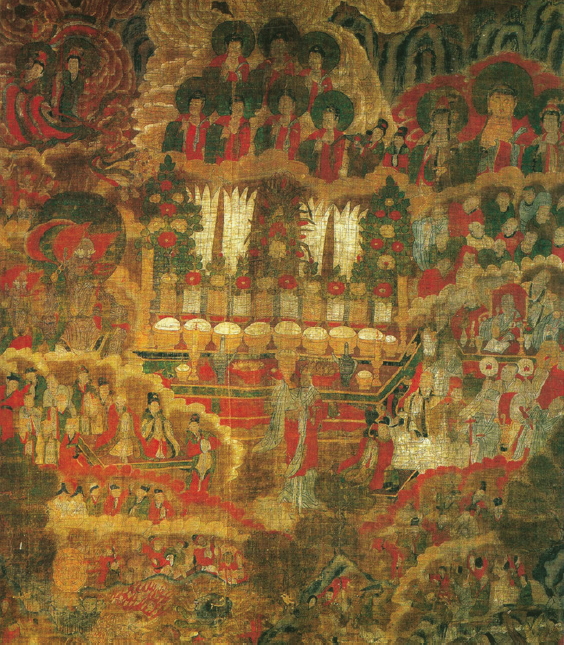
Fig. 5.
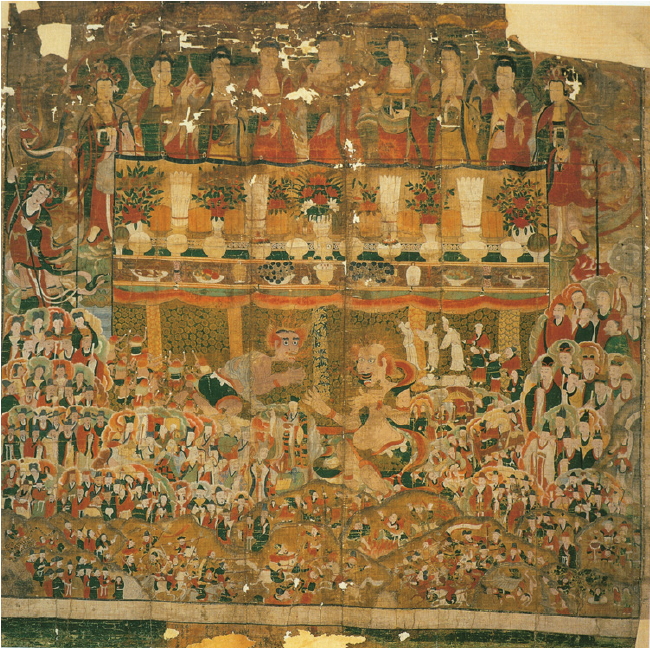
Fig. 6.
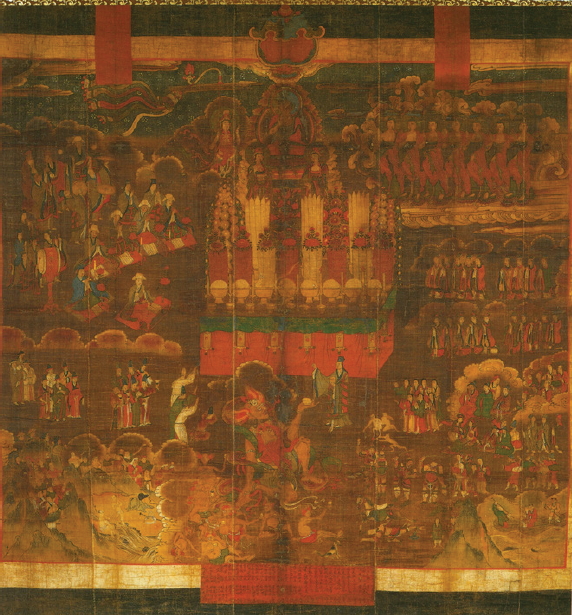
Fig. 7.
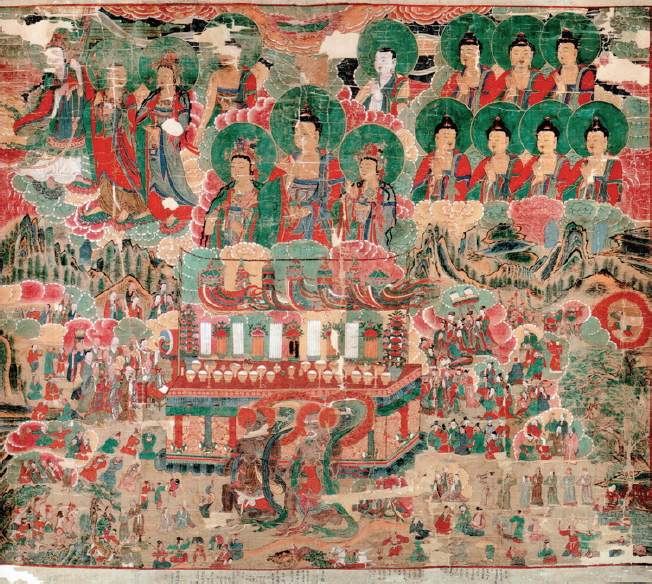
Fig. 8.

Fig. 9.

Fig. 10.
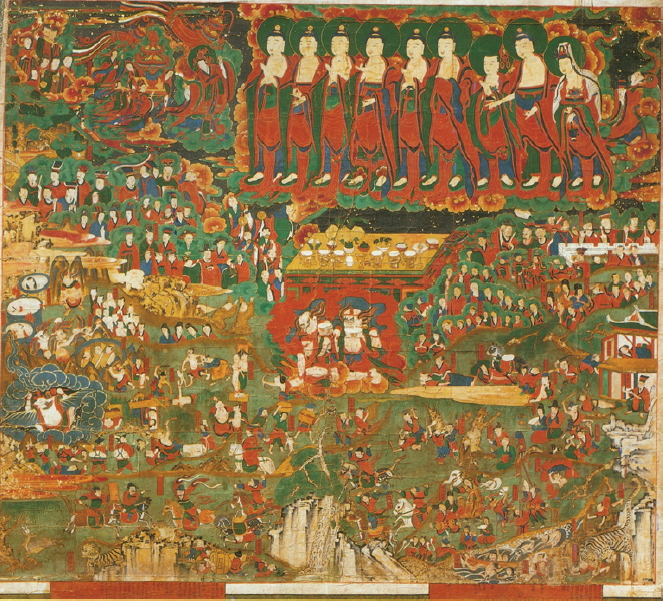
Fig. 11.

Fig. 12.
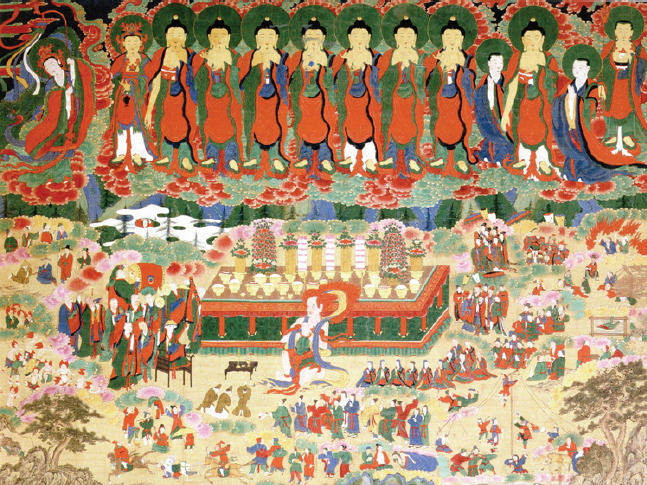
Fig. 13.
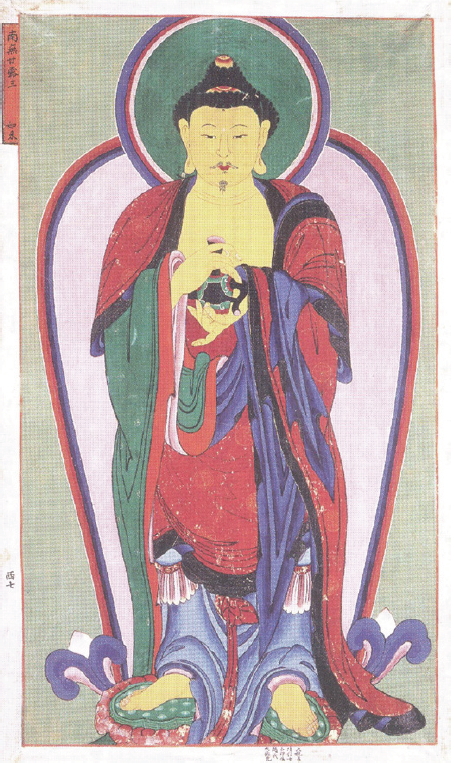
Fig. 14.

Fig. 15.
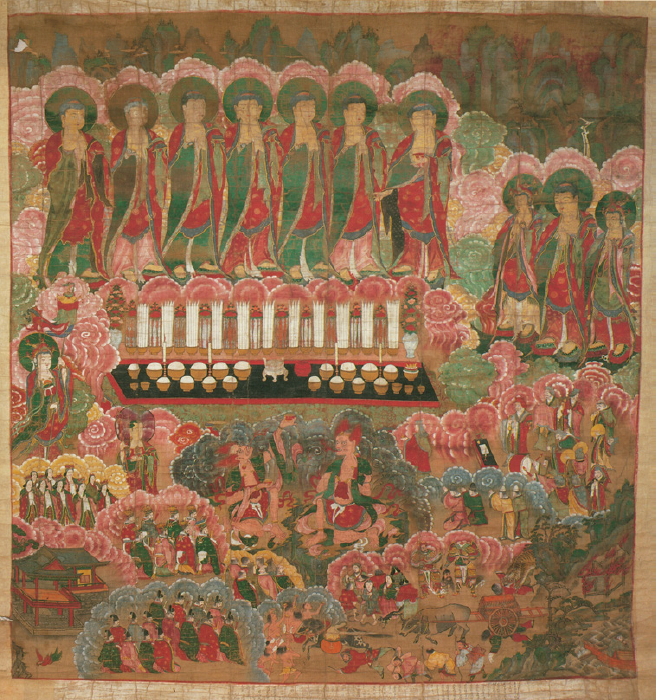
Fig. 16.
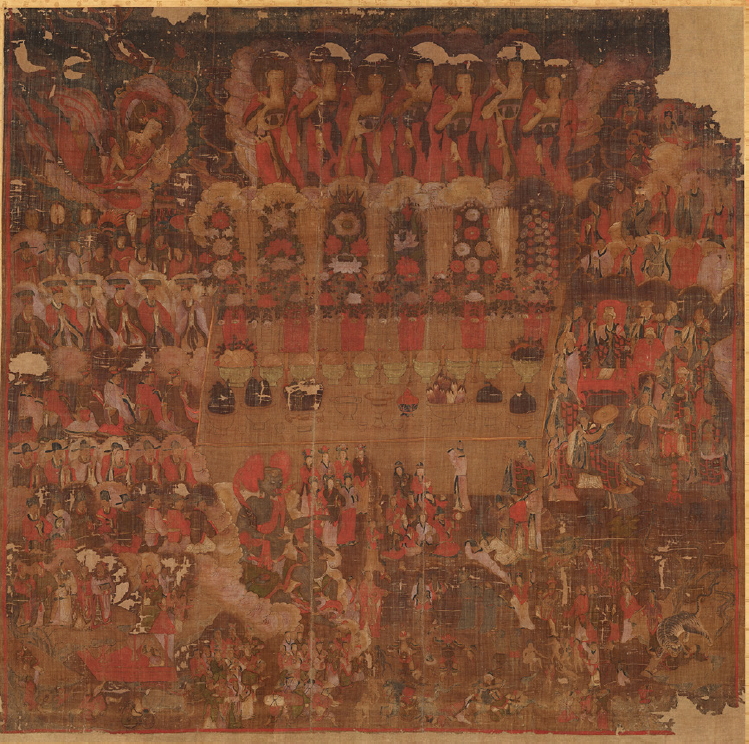
<Table 1>
| Mode of Configuration | Five Buddhas | Seven Buddhas | ||
|---|---|---|---|---|
| Single composition | At the center | 3 | At the Center | 57 |
| On the side or encircled around the Amitābha triad | 3 | |||
| At the central plane juxtaposed with another group of Buddhas | 2 [14] | |||
| Variant composition | - | - | A group of six Buddhas aligned with the Amitābha triad | 3 |
| The Amitābha Triad disjoined from the group of six Buddhas | 6 | |||
| Subtotal | 3 | 71 | ||
| Total | 74 | |||
<Table 2>
<Table 3>
References
- TOOLS




